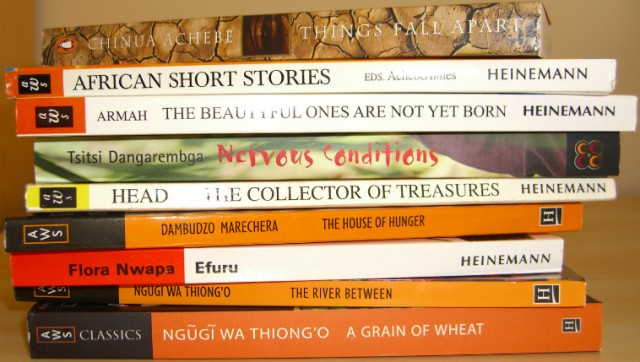Publishing
Writing and LITERATURE have a long history in Africa, beginning in ancient EGYPT with the picture-writing called hieroglyphics. Publishing traces its roots to the rise of Islam on the continent, and printed works in Arabic appeared in major cities and trading centers by the 1600s. However, it was through the work of European missionaries and colonial governments in the 1800s and 1900s that publishing became established and spread throughout Africa. Today small publishing industries exist in every African country.

Early Book Publishing in Africa
Missionaries brought printing presses to Africa as early as the mid-1700s and produced Bibles, prayer books, and hymn books in many indigenous LANGUAGES. Because these languages lacked written forms, missionaries first had to compile vocabulary lists and grammars. Within 100 years, presses were running in NIGERIA, KENYA, and SOUTH AFRICA, and some of them still exist today. By the early 1930s, many colonial governments had set up Vernacular (in the local language) Literature Bureaus to publish reading materials for an African audience. In 1931, Algerian reformers founded the Association of Algerian Muslim Ulama to encourage Islamic culture and Arabic language in the face of French colonialism. The association ran a press that nurtured the growth of Algerian Arabic literature by publishing local poetry and fiction.
The rapid expansion of EDUCATION in Africa after World War II—especially as countries won their independence—led to a great need for textbooks. Most of these books were published abroad and did not serve the needs of African readers. Many contained material that was racist. Books written in Africa by Africans did not become widely available until the 1960s.
By the 1970s, indigenous publishers were expanding their businesses and began to challenge the dominance of foreign publishing corporations. However, economic crises in the 1980s took a severe toll as governments cut funds that supported publishing and libraries. Even where governments remained involved, publishing suffered from government bureaucracy, inefficiency, and censorship.
Book Publishing Today
African book publishers today face a variety of special problems involving the size of the market. The continent's literacy rate of less than 50 percent limits the number of people who can read or buy books. Publishers can rarely market a book widely because Africans speak a great variety of languages, none of which is common throughout the continent. One option is to write and publish in European languages that more people speak but few people favor. In addition, distributing the books is difficult because economic declines of recent years have led to unreliable electricity, poor roads, and few vehicles.
African publishers have responded to these challenges in many ways. Some have promoted inexpensive paperback novels designed to appeal to a popular audience. Some critics have attacked these books for questionable morals, but such novels have attracted many new readers who previously had little enthusiasm for books.
African publishers have also joined together in groups such as the African Publishers Network, which trains people who work in publishing. The African Books Collective works to win an international audience for African literature and to promote writing and scholarship in Africa. A major prize called the Noma Award has also encouraged the growth of the industry.
Newspapers and Periodicals
Colonial governments supported many newspapers, magazines, and journals for the benefit of European settlers. Colonial newspapers typically backed government policies and the interests of the settlers against the rights of indigenous peoples. Among the first was Al-Mubashir, printed in 1847 in Algeria. In other colonies, an opposition press developed to give voice to African ideas, to challenge official policies, and to promote independence. Examples of such early publications were Muiguithania in Kenya and Drum in South Africa.
After independence, many African rulers took control over the main newspapers to reduce the ability of the press to criticize their governments. However, by the 1980s pressure for more open government led to greater freedom for the African press. When MALAWI's president agreed to allow opposition political parties in 1993, the country had only two newspapers. Three years later, more than 15 publications covered Malawi's politics, economics, and social issues.
However, many states still exercise control over the media, and publishers that challenge government policies or officials often face harassment and imprisonment. So many attacks have been made against journalists and publishers in TUNISIA that the country's president, Zine el-Abidine Ben Ali, has been declared one of the world's top ten enemies of the press. Nigeria and Kenya boast vigorous local presses, but the governments of those nations often shut down newspapers and magazines that criticize too harshly. Yet the publications least likely to support government policies are often the most popular. In 1996 the circulation of Kenya's independent daily paper, The Nation, reached about 190,000, while that of the government-owned Kenya Times remained at about 6,000.
As Africa moves into the twenty-first century, illiteracy, financial difficulties, and undemocratic governments present the main challenges to developing a free and financially sound press. However, African publishers have so far shown remarkable durability and resourcefulness under difficult conditions. Those that survive could play a major role in addressing the continent's political and social problems. (See also Christianity in Africa, Colonialism in Africa, Missions and Missionaries.)